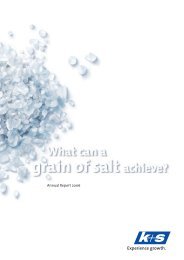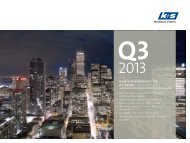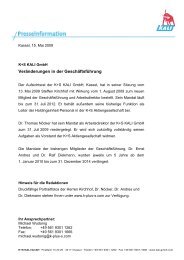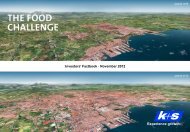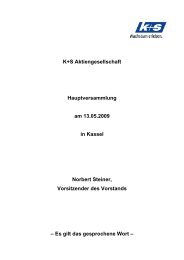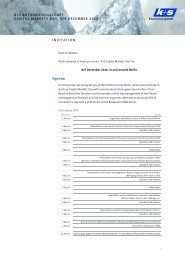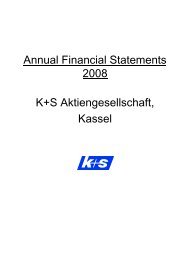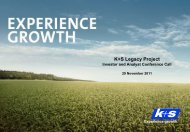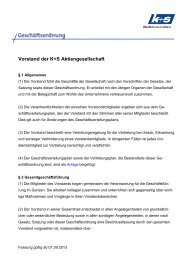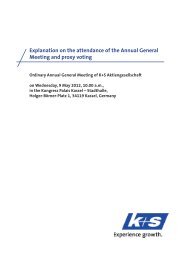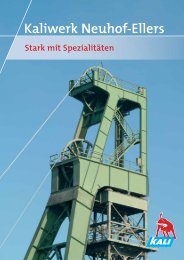Handout - K+S Aktiengesellschaft
Handout - K+S Aktiengesellschaft
Handout - K+S Aktiengesellschaft
You also want an ePaper? Increase the reach of your titles
YUMPU automatically turns print PDFs into web optimized ePapers that Google loves.
Roadshow New York<br />
21-22 March 2013<br />
March 2013<br />
Experience growth.<br />
<strong>K+S</strong> Group
<strong>K+S</strong> Group<br />
Content<br />
A. Corporate Structure & Strategy 1<br />
B. Potash and Magnesium Products 4<br />
C. Salt 29<br />
D. Complementary Activities 39<br />
E. Financial Data 41<br />
F. Outlook 52<br />
G. <strong>K+S</strong> Share 56<br />
March 2013 <strong>K+S</strong> Group 1
<strong>K+S</strong> Group<br />
Why invest in <strong>K+S</strong>?<br />
<strong>K+S</strong>…<br />
• … has access to megatrends of growing population, increasing living standards and<br />
changing diets toward higher meat consumption in developing countries<br />
• … is active in the growing potash fertilizer market having an attractive consolidated supply<br />
structure and high barriers to entry. Potash does not have any substitutes<br />
• … is a unique strategic combination of potash and salt with considerable synergies on<br />
production side and by being complementary on sales side<br />
• … has leading positions in potash and magnesium (big volume player in Europe,<br />
No. 5 worldwide)<br />
• … has a substantial capacity growth potential with the Legacy Project (set up of a potash<br />
solution mine) in Canada<br />
• … is the global leader in salt with leading positions in Europe, South and North America and<br />
with diversification through the global footprint and various end markets<br />
• … has very strong financials<br />
• … has a responsible management team with strong operational background and track record<br />
of creating value<br />
March 2013 <strong>K+S</strong> Group 2
<strong>K+S</strong> Group<br />
Focus on two strong Pillars<br />
<strong>K+S</strong> Group<br />
Revenues 2012: € 3.9 billion (2011: € 4.0 billion)<br />
EBIT I 2012: € 808,5 million (2011: € 906.2<br />
Potash and Magnesium<br />
Products Business Unit<br />
Salt Business Unit<br />
1,422<br />
Revenue / EBIT I in € million<br />
1,867 2,134<br />
232 476<br />
740<br />
2,291<br />
774<br />
Revenue / EBIT I in € million<br />
1,729 1,710<br />
1,015<br />
140 238<br />
211<br />
1,485<br />
62<br />
Complementary Activities (Revenues 2012: € 154 million; EBIT 2012: € 21 million)<br />
Waste Management & Recycling<br />
Logistik<br />
Animal Hygiene Products<br />
Trading business (CFK)<br />
March 2013<br />
<strong>K+S</strong> Group<br />
3
<strong>K+S</strong> Group<br />
Content<br />
A. Corporate Structure & Strategy 1<br />
B. Potash and Magnesium Products 4<br />
C. Salt 29<br />
D. Complementary Activities 39<br />
E. Financial Data 41<br />
F. Outlook 52<br />
G. <strong>K+S</strong> Share 56<br />
March 2013 <strong>K+S</strong> Group 4
Potash and Magnesium Products<br />
What are the Demand Drivers for Fertilizers?<br />
• Despite decreasing availability of arable farm land, global production of agricultural products<br />
has to be increased:<br />
• steadily increasing world population<br />
• changing diets toward higher meat consumption (e.g. 1 kg beef = 8 kg animal feed)<br />
• increasing importance of renewable raw materials for the production of bio energy<br />
• Fertilizing with the key nutrients nitrogen (N), phosphate (P)<br />
and potash (K), but also increasingly magnesium (Mg) and sulphur (S)<br />
is necessary to cope with this challenge<br />
• Nutrients cannot be substituted and a balanced fertilization of all nutrients is<br />
necessary to achieve optimal yields. Emerging countries, in particular, should<br />
significantly increase the potash proportion of their total fertilizer application<br />
• Medium- and long-term increase in global fertilizer consumption (N, P and K)<br />
of 2% to 3% p.a. is expected (Source: IFA)<br />
Advantage:<br />
<strong>K+S</strong> offers its worldwide customers important nutrients<br />
in a market-oriented specialised product range<br />
March 2013 <strong>K+S</strong> Group 5
Potash and Magnesium Products<br />
Low Stocks-to-use Ratios of Agricultural Products<br />
Production and demand development vs. stocks-to-use ratio (Wheat and coarse grains)<br />
Production<br />
Demand<br />
Stocks-to-use<br />
45.0<br />
40.0<br />
35.0<br />
30.0<br />
25.0<br />
Critical Level<br />
20.0<br />
15.0<br />
• Over the past thirty years, annual global production has often fallen short of demand.<br />
• Despite reasonable harvest levels during the last ten years, these structural supply and<br />
demand gaps have resulted in historically low stocks-to-use ratios. This ratio relates available<br />
stocks to estimated demand of one year and therefore can be translated into the number of days the stocks<br />
would last without any new harvests. A stocks-to-use ratio of 20% can be translated into 73 days.<br />
• The production level for the agricultural year 2012/13 expected by the USDA will not be efficient to meet<br />
consumption, so that stocks-to-use ratio will remain very low (17,8% or 65 days).<br />
March 2013 <strong>K+S</strong> Group 6<br />
2011/12e<br />
Source: USDA; as of 8 March 2013<br />
e<br />
10.0<br />
5.0<br />
0.0
Potash and Magnesium Products<br />
Prices for Agricultural Products – Spot vs. Future<br />
Prices for Agricultural Products – spot<br />
Prices for Agricultural Products – future<br />
450%<br />
400%<br />
350%<br />
300%<br />
250%<br />
200%<br />
150%<br />
100%<br />
50%<br />
2005 2006 2007 2008 2009 2010 2011 2012 March’13 Dec.’13<br />
May.‘14<br />
Corn<br />
Wheat<br />
Soybeans<br />
Palmoil<br />
• High price level for agricultural products in<br />
2012, despite slight decreases towards<br />
the end of the year<br />
Source: Bloomberg; as of 18 March 2013<br />
• Future prices of agricultural products<br />
show that capital markets expect price<br />
levels to be attractive for the next two<br />
years<br />
March 2013 <strong>K+S</strong> Group 7
Potash and Magnesium Products<br />
How is the Profitability of Winter Wheat in Europe?<br />
2009<br />
2010<br />
2011<br />
2012<br />
2013e<br />
2.000<br />
Costs Sales<br />
1,213 964<br />
Costs Sales<br />
1,067 1,595<br />
Costs Sales<br />
1,116 1,405<br />
Costs Sales<br />
1,205 1,909<br />
Costs Sales<br />
1,196 1,632<br />
1.500<br />
1.000<br />
500<br />
0<br />
Risk of<br />
loss:<br />
-249 €<br />
Profit<br />
potential:<br />
528 €<br />
Profit<br />
potential :<br />
289 €<br />
Profit<br />
potential :<br />
704 €<br />
326<br />
248 242<br />
175 225<br />
82 82<br />
69 75 75<br />
101 101 101 121 121<br />
189 157<br />
157 162 162<br />
513 541 541 567 567<br />
Profit<br />
potential :<br />
436 €<br />
Wheat price: 123 €/t Wheat price: 220 €/t Wheat price: 199 €/t Wheat price: 258 €/t Wheat price: 220 €/t<br />
2009 2010 2011 2012 2013e<br />
Yield: 7.84 t/ha Yield: 7.25 t/ha Yield: 7.06 t/ha Yield: 7.40 t/ha Yield: 7.42 t/ha<br />
Year<br />
2009<br />
2010<br />
2011<br />
2012<br />
2013e<br />
Fertilizer share of total costs<br />
27% fertilizer costs (4% K)<br />
16% fertilizer costs (3% K)<br />
20% fertilizer costs (2% K)<br />
21% fertilizer costs (3% K)<br />
20% fertilizer costs (3% K)<br />
Fertilization<br />
Other costs<br />
(e.g. insurance, water)<br />
Seeds/plants<br />
Plant protection agents<br />
Variable costs<br />
Fixed costs (inkl. lease)<br />
March 2013<br />
The current future curve of the wheat price should enable the farmer to realize a profit potential of around<br />
€ 700 per hectare (excl. subsidies) in 2012 and around € 440 in 2013e. This is a high level compared to the<br />
last years; the application of fertilizers is profitable.<br />
Assumptions: without agricultural subsidies, incl. interest expenses for pre-financing costs, 100% use of mineral fertilizers (no organic fertilizing), straw stays in the field (straw fertilizing); fertilizer<br />
use for 8 t/ha yield: 80 kg/ha MOP, 536 kg/ha KAS and 139 kg/ha TSP; for lower yields, lower fertilizer requirement adjusted accordingly; Sources: costs (20 ha) according to Kuratorium für<br />
Technik und Bauwesen in der Landwirtschaft e. V. (KTBL) for winter wheat – bread quality, rotating crop growing system; yield according to statistical year book for food nutrition, agriculture and<br />
forestry 2011 and 2012, 2013e: 10-year average; nutrient extractions according to Guidelines for Fertilizer Use in Germany; fertilizer prices taken from LAND & Forst at the point of the upcoming<br />
fertilization (general fertilization with potash and phosphate in September; nitrogen fertilization in September, February, April and June); wheat price (bread quality B) according to LAND & Forst<br />
(average delivery from the yard from July to February), 2012e and 2013e: Euronext price less transportation cost assumption.<br />
<strong>K+S</strong> Group<br />
8
Potash and Magnesium Products<br />
How is the Supplier Structure on the Potash Market?<br />
Figures in %<br />
32.8 32.9<br />
32.0<br />
30.7 30.4<br />
2009 2010 2011<br />
23.0<br />
13.9<br />
11.2<br />
9.9<br />
9.5<br />
8.6<br />
9.5<br />
8.6<br />
8.5<br />
9.3<br />
3.1<br />
3.6<br />
3.7<br />
2.7<br />
2.6<br />
2.6<br />
4.7<br />
3.2<br />
3.0<br />
BPC<br />
• Belaruskali<br />
• Uralkali/<br />
Silvinit<br />
Canpotex<br />
• Potash<br />
Corp<br />
• Mosaic<br />
• Agrium<br />
<strong>K+S</strong><br />
ICL<br />
• DSW<br />
• CPL<br />
• Iberpotash<br />
participation<br />
Sales volumes in metric tonnes<br />
of Potash<br />
Sources: IFA, <strong>K+S</strong><br />
Corp. in ICL<br />
March 2013 <strong>K+S</strong> Group 9<br />
APC<br />
participation<br />
of Potash<br />
Corp.<br />
SQM<br />
participation<br />
of Potash<br />
Corp.<br />
China<br />
• more<br />
than 20<br />
producers<br />
Others<br />
• Intrepid<br />
• Vale<br />
• Compass
Potash and Magnesium Products<br />
What are the major Production and Application Areas?<br />
Million tonnes<br />
20.1<br />
19.7<br />
28.5<br />
10.2<br />
7.1 5.9<br />
4.4<br />
10.8<br />
10.5<br />
2.2<br />
0.7<br />
Incl. sulphate of potash<br />
and low-grade potash<br />
Sources: IFA, <strong>K+S</strong><br />
World potash production:<br />
2011: 59.9 million t<br />
2010: 55.5 million t<br />
2009: 33.7 million t<br />
World potash sales:<br />
2011: 60.2 million t<br />
2010: 58.3 million t<br />
2009: 31.0 million t<br />
March 2013 <strong>K+S</strong> Group 10
Potash and Magnesium Products<br />
Where does Demand Growth come from?<br />
World<br />
Developed markets<br />
40.000<br />
32.000<br />
20.000<br />
16.000<br />
North America, Western/Central Europe, Oceania<br />
1.000 t K 2 O<br />
24.000<br />
16.000<br />
1.000 t K 2 O<br />
12.000<br />
8.000<br />
8.000<br />
4.000<br />
0<br />
80/81 84/ 88/ 92/ 96/ 00/ 04/ 08/ 12/f<br />
0<br />
80/81 84/ 88/ 92/ 96/ 00/ 04/ 08/ 12/f<br />
Transitional markets<br />
Emerging markets<br />
10.000<br />
Eastern Europe and Central Asia<br />
24.000<br />
Latin America, Asia, Africa<br />
8.000<br />
20.000<br />
1.000 t K 2 O<br />
6.000<br />
4.000<br />
2.000<br />
1.000 t K 2 O<br />
16.000<br />
12.000<br />
8.000<br />
4.000<br />
0<br />
0<br />
80/81 84/ 88/ 92/ 96/ 00/ 04/ 08/ 12/f<br />
80/81 84/ 88/ 92/ 96/ 00/ 04/ 08/ 12/f<br />
Source: IFA<br />
March 2013 <strong>K+S</strong> Group 11
Potash and Magnesium Products<br />
How much Potash is consumed in each Region?<br />
Million tonnes<br />
2013e<br />
2012e<br />
2011<br />
2010<br />
2009<br />
2008<br />
Western Europe<br />
5.8<br />
5.2<br />
5.9<br />
6.7<br />
2.7<br />
6.3<br />
Central Europe / FSU<br />
5.0<br />
4.8<br />
4.4<br />
4.9<br />
3.1<br />
5.0<br />
Africa<br />
0.8<br />
0.7<br />
0.7<br />
0.8<br />
0.3<br />
0.6<br />
North America<br />
10.3<br />
8.5<br />
10.2<br />
10.8<br />
4.1<br />
10.2<br />
Latin America<br />
10.5<br />
10.5<br />
10.5<br />
9.7<br />
6.0<br />
8.6<br />
Asia<br />
26.0<br />
23.9<br />
28.0<br />
24.9<br />
14.6<br />
23.2<br />
- thereof China<br />
~ 13<br />
12.2<br />
12.7<br />
10.2<br />
5.4<br />
8.8<br />
- thereof India<br />
~ 4<br />
3.2<br />
5.0<br />
6.1<br />
5.5<br />
6.2<br />
Oceania<br />
0.6<br />
0.4<br />
0.5<br />
0.5<br />
0.2<br />
0.6<br />
World total<br />
~ 59<br />
~ 54<br />
60.2<br />
58.3<br />
31.0<br />
54.5<br />
● In 2012, worldwide potash sales volumes amounted to around 54 million tonnes with declines<br />
especially in China, India and the US.<br />
● In 2013, we expect worldwide potash sales volumes of about 59 million tonnes.<br />
Incl. potassium sulphate and potash grades with lower K 2 O content of around 3 million tonnes eff;<br />
Sources: IFA, <strong>K+S</strong><br />
March 2013 <strong>K+S</strong> Group 12
Potash and Magnesium Products<br />
Are new Potash Capacities needed?<br />
Million tonnes<br />
Greenfield projects<br />
Brownfield projects<br />
Available capacity<br />
Production<br />
Sales<br />
China<br />
Financial<br />
crisis<br />
Reliability of forecast<br />
quality questionable<br />
India<br />
68<br />
●<br />
●<br />
Long-term demand growth<br />
of 3 to 5% p.a.<br />
The available capacities<br />
will not be sufficient.<br />
Soviet Union<br />
~59<br />
64<br />
●<br />
IFA data (basis for capacity<br />
expansion forecast) showed<br />
poor forecast quality in the<br />
past (due to project<br />
postponements and delays).<br />
●<br />
Brownfield projects shown<br />
are all in the hands of existing<br />
producers, who proved to<br />
consistently match supply with<br />
market demand.<br />
1988 ’93 ’01 ’02 ’03 ’04 ’05 ’06 ’07 ’08 ’09 ’10 ’11 ’12 ‘13<br />
‘14 ‘15 ‘16<br />
(e)<br />
Incl. potassium sulphate and potash grades with lower K 2 O content of around 3 million tonnes eff;<br />
Capacity development 2011-2016 based on IFA supply capability data.<br />
Sources: IFA, <strong>K+S</strong><br />
March 2013 <strong>K+S</strong> Group 13
Potash and Magnesium Products<br />
How Reliable is the Forecast Quality of Capacities?<br />
Million tonnes<br />
85<br />
IFA Supply Capability Data 2009<br />
IFA Supply Capability Data 2012<br />
80<br />
Year 2013<br />
Forecast 2009 vs.<br />
2012:<br />
estimate reduction of<br />
> 6 million tonnes<br />
75<br />
70<br />
65<br />
Year 2012<br />
Forecast 2009 vs.<br />
2012:<br />
estimate reduction of<br />
> 7 million tonnes<br />
60<br />
2011 2012 2013 2014 2015<br />
Incl. potassium sulphate and potash grades with lower K 2 O content of around 3 million tonnes eff;<br />
Capacity development 2011-2015 based on IFA supply capability data.<br />
Sources: IFA, <strong>K+S</strong><br />
March 2013<br />
<strong>K+S</strong> Group<br />
14
Potash and Magnesium Products<br />
How did MOP Prices develop?<br />
US$/t<br />
Northwest-Europe (standard, fob)<br />
US$/t<br />
Overseas (cfr)<br />
Brazil<br />
(granular)<br />
*<br />
South-East Asia<br />
(SEA, standard)<br />
411<br />
445-455<br />
2003 ‘04 ‘05 ‘06 ‘07 ‘08 ‘09 ‘10 ‘11 ‘12 2013 2003 ‘04 ‘05 ‘06 ‘07 ‘08 ‘09 ‘10 ‘11 ‘12 2013<br />
● Due to the tight demand-supply-situation, potash prices more than doubled between 2004 and 2007<br />
●<br />
●<br />
●<br />
The strong and in part speculatively driven raw materials boom which was observable worldwide until mid-2008<br />
also had an effect in significant price increases to over 800 US$/tonne of granulated potassium chloride<br />
The collapse in agricultural prices as a consequence of the financial crisis also led to a decrease in potash prices;<br />
a price level of approximately 400 US$/tonne of granulated potassium chloride was established at the beginning of<br />
2010. This increased gradually as part of an improving agricultural environment and thus took into account the fact<br />
that time-consuming and capital-intensive greenfield projects for the creation of new capacities can only be realised<br />
economically with a reasonable potash price level<br />
Pricing pressure at the end of 2012 due to the lack of contracts with China and India, followed by a stabilisation at<br />
the beginning of 2013 after the conclusion of new contracts<br />
March 2013 * Until end of September 2010 MOP standard; Source: FMB<br />
<strong>K+S</strong> Group 15
Potash and Magnesium Products<br />
How is the Business Unit performing?<br />
Revenues (€ billion) EBIT (€ million)<br />
Highlights 2012<br />
0.54<br />
0.47<br />
2.13<br />
2.29<br />
Q4/11 Q4/12 FY/11 FY/12<br />
1.9<br />
2.1<br />
2.3<br />
2010 2011 2012<br />
181<br />
476<br />
166<br />
740<br />
774<br />
Q4/11 Q4/12 FY/11 FY/12<br />
740 774<br />
2010 2011 2012<br />
• After there was still cautious early stocking-up of<br />
fertilizers at the start of the year, the demand<br />
developed positively during Q2.<br />
• In Q3/12, due to the attractive prices for agricultural<br />
raw materials, demand was at a good level for<br />
agricultural raw materials demand was at a good level<br />
in the markets relevant for <strong>K+S</strong>. However, against the<br />
backdrop of still outstanding contract conclusions in<br />
China and India, international prices for potassium<br />
chloride came under pressure in the fourth quarter, but<br />
were in 2012 on average above those of 2011.<br />
Revenue split 2012 Outlook 2013*<br />
Industrial<br />
products<br />
12%<br />
Fertilizer<br />
specialities 37%<br />
By product group<br />
Potassium<br />
chloride 51%<br />
Asia<br />
20%<br />
By region<br />
South<br />
America<br />
23%<br />
North America<br />
3%<br />
Africa, Oceania<br />
5%<br />
Europe<br />
49%<br />
• Sales volumes expected at about 7 million t<br />
(2012: 6.95 million t)<br />
• Average price level expected below that of 2012<br />
• On this basis, revenues should decrease. With<br />
costs expected to be stable, operating earnings<br />
should also be below the level of 2011.<br />
March 2013 *<br />
Outlook as of 27 February 2013<br />
<strong>K+S</strong> Group 16
Potash and Magnesium Products<br />
How is the Product Portfolio structured?<br />
Non-potash-containing products<br />
2011: 1.21 million tonnes<br />
(2010: 1.24)<br />
● Fertilizer specialities<br />
- ESTA ® Kieserite<br />
- EPSO ® Product family<br />
● Industrial products<br />
- Magnesium sulphate<br />
- Magnesium chloride<br />
Fertilizer<br />
specialities<br />
2.96<br />
Industrial<br />
products<br />
0.74<br />
Potassium<br />
chloride<br />
3.25<br />
Potash-containing products<br />
2011: 5.75 million tonnes<br />
(2010: 5.70)<br />
● Potassium chloride<br />
- MOP - Standard<br />
- MOP - Granular<br />
● Fertilizer specialities<br />
- Potassium sulphate<br />
- Patentkali ®<br />
- Korn-Kali ® products<br />
- Magnesia-Kainit ®<br />
● Industrial products<br />
- Potassium chloride, 97% - 99% KCl<br />
- Potassium sulphate, > 95% K 2 SO 4<br />
- High purity salts<br />
Broad and less cyclical product portfolio allows flexible reaction on fluctuation in demand<br />
March 2013 <strong>K+S</strong> Group 17
Potash and Magnesium Products<br />
How is the Cost Structure?<br />
2008 2009 2010 2011 2012 2013e<br />
÷<br />
–<br />
=<br />
=<br />
Revenues (€ million) 2,397.4 1,421.7 1,867.0 2,133.6 2,290.6 -<br />
EBIT (€ million) 1,203.2 231.7 475.9 739.5 773.9 -<br />
Costs (€ million) 1,194.2 1,190.0 1,391.1 1,394.1 1,516.7 ○<br />
thereof personnel (€ million) 465 440 506 535 550 ○<br />
thereof freight (€ million) 227 155 264 268 280 ○<br />
thereof freight (€/t) 33 36 37 39 40 ○<br />
thereof material (€ million) 265 183 229 249 257 ○<br />
thereof energy (€ million) 186 144 172 195 230 -<br />
thereof depreciation (€ million) 83 86 91 94 96 +<br />
thereof other (€ million) (32) 182 129 53 104 ○<br />
Sales Volumes (million t) 6.99 4.35 7.06 6.94 6.95 ○<br />
Total Unit Costs (€/t) 170.8 273.6 197.0 200.9 218.2 ○<br />
• In 2012, average unit costs rose tangibly. In 2013 in total, we expect a largely stable cost level.<br />
March 2013 <strong>K+S</strong> Group 18
Potash and Magnesium Products<br />
What are major Destinations for <strong>K+S</strong>?<br />
> 1%<br />
Sales volumes > 5%<br />
Sales volumes by region<br />
2012 2011<br />
Europe 51% 54%<br />
- of which: Germany 15% 16%<br />
North America 2% 2%<br />
South America 21% 18%<br />
Asia 22% 22%<br />
Africa, Oceania 4% 4%<br />
March 2013 <strong>K+S</strong> Group 19
Potash and Magnesium Products<br />
Are there Price Differences in the Product Portfolio?<br />
€/t<br />
700<br />
600<br />
500<br />
400<br />
300<br />
200<br />
<strong>K+S</strong> Ø-Portfolio-Price vs. MOP gran. Europe<br />
<strong>K+S</strong> Ø-Portfolio Price<br />
MOP gran. Europe<br />
∆<br />
~10-20%<br />
€/t<br />
900<br />
800<br />
700<br />
600<br />
500<br />
400<br />
300<br />
200<br />
SOP Ø-Price vs. MOP gran. Europe<br />
SOP Ø-Price Europe (std.and gran.)<br />
MOP gran.<br />
Europe<br />
100<br />
2006 2007 2008 2009 2010 2011 2012<br />
100<br />
2006 2007 2008 2009 2010 2011 2012<br />
€/t<br />
600<br />
500<br />
400<br />
300<br />
200<br />
<strong>K+S</strong> Industrial Ø-Price vs. MOP gran. Europe<br />
<strong>K+S</strong> Ø Industrial Portfolio Price<br />
MOP gran. Europe<br />
<strong>K+S</strong> non potash specialities Industr. vs. Fertiliz.<br />
€/t<br />
450<br />
400<br />
350<br />
300<br />
250<br />
200<br />
150<br />
100<br />
50<br />
Industrial Magnesium Comp.<br />
Fertilizer Magnesium Comp.<br />
100<br />
2006 2007 2008 2009 2010 2011 2012<br />
2006 2007 2008 2009 2010 2011 2012<br />
March 2013 Sources: <strong>K+S</strong>, FMB International Price Guide, Green Markets, Fertilizer Europe<br />
<strong>K+S</strong> Group 20<br />
0
Legacy Project<br />
What Relevance do the Activities in Canada have?<br />
• With Potash One, <strong>K+S</strong> has acquired<br />
several potash exploration permits in<br />
Saskatchewan/Canada (incl. the<br />
Legacy Project and its feasibility<br />
study).<br />
Southern area of the potash belt of Saskatchewan<br />
(Schematic Diagram)<br />
• The total purchase price was<br />
€ 322.5 million (CAD 4.50 per share).<br />
• The Legacy Project is an advanced<br />
greenfield project for which an<br />
environmental permit has been granted.<br />
• Potash One is now fully incorporated<br />
in <strong>K+S</strong> Potash Canada GP.<br />
Two more potash exploration licences close to Esterhazy<br />
Reserves and Resources<br />
in mln. t KCl % KCl % K 2<br />
O<br />
Reserves (Proven and Probable Reserves) Legacy Project area 160 29 18<br />
Resources (Inferred and Indicated Resources) Legacy Project area + KLSA 009 981 27 17<br />
The reserves figures were determined in accordance with the requirements of the Canadian standard Nl 43-101 of the “Canadian Securities Regulators”.<br />
March 2013 <strong>K+S</strong> Group 21
Legacy Project<br />
How is the Ramp-up of the Legacy Project planned?<br />
Production capacity<br />
in mln. t KCl/a<br />
4.0<br />
3.5<br />
3.0<br />
2.5<br />
2.0<br />
1.5<br />
1.0<br />
0.5<br />
0.0<br />
Phase 2 – Development of secondary mining<br />
Phase 1 – Primary mining<br />
Outlook for Phase 3 –<br />
Expansion of secondary mining<br />
2011'12 '13 '14 '15 '16 '17 '18 '19 '20 '21 '22 '23 '24 '25 '26 '27 '28 '29 '30 '31 '32 '33 '34 '35<br />
1.14<br />
0.86<br />
2.00<br />
Phase 1<br />
(Implementation: 2011 to 2017)<br />
Phase 2<br />
(Implementation: 2016 to 2023)<br />
Outlook for Phase 3<br />
(Implementation: 2023 to 2034)<br />
● Development of infrastructure mainly for Phases 1 + 2, preparations for Phase 3<br />
● Capacity development + ramp-up of production to 2.0 mln. t KCl/a through primary mining<br />
● Capacity expansion and ramp-up of production by 0.86 to 2.86 mln. t KCl/a<br />
through secondary mining (share of secondary mining in total capacity: 30%)<br />
● Increase in share of secondary mining in total capacity to 50%<br />
● Potential expansion of annual capacity by 1.14 to 4.0 mln. t KCl/a<br />
March 2013 <strong>K+S</strong> Group 22
Legacy Project<br />
How will the Course of Capex be?<br />
Phase 1<br />
Phase 2<br />
Phase 3<br />
Activity<br />
Primary mining: Development of<br />
first caverns and construction<br />
of production and<br />
infrastructure facilities<br />
Development of secondary mining,<br />
expansion of production and<br />
logistics facilities<br />
Further expansion of secondary<br />
mining, construction of necessary<br />
additional production and logistics<br />
facilities<br />
Production<br />
capacity after<br />
implementation<br />
as of 2017:<br />
2.00 million tonnes KCl/a<br />
as of 2023:<br />
2.86 million tonnes KCl/a<br />
probably as of 2034:<br />
4.00 million tonnes KCl/a<br />
Capex 2011 to 2016: CAD 2.90 billion* 2016 to 2022: CAD 0.35 billion* 2023 to 2034: ~ CAD 0.70 billion<br />
Diagram of<br />
course of<br />
investment<br />
2011 2012 2013 2014 2015 2016 2016 2017 2018 2019 2020 2021 2022<br />
March 2013 * Approved by the Supervisory Board<br />
<strong>K+S</strong> Group 23
Legacy Project<br />
What will be the specific Cash Costs*?<br />
CAD/tonne<br />
175<br />
150<br />
125<br />
100<br />
75<br />
50<br />
25<br />
~ 165 CAD/tonne<br />
Average<br />
logistic<br />
costs<br />
Cash costs of<br />
production:<br />
~ 95 CAD/tonne<br />
● The cash costs of production will be lower for<br />
Legacy than in our plants in Germany<br />
● The high share of variable cost components<br />
(incl. freight) makes possible greater flexibility in<br />
relation to capacity utilisation:<br />
Legacy: 2/3 variable; 1/3 fixed<br />
Germany: 1/3 variable; 2/3 fixed<br />
● For mining taxes/royalties, an additional approx.<br />
CAD 70/tonne are to be recognised on the basis<br />
of a potash price of US$ 450/tonne ex works<br />
● Over the long term, depreciation and<br />
amortisation will total about CAD 30/tonne after<br />
initially higher values at the start of production<br />
0<br />
* At full utilisation of 2.86 million tonnes KCl/a (Phases 1+2)<br />
Assumptions: gas price: CAD 4.30/MMBtu; exchange rate: 1.02 CAD/USD; no increase in prices and costs after the construction phase<br />
March 2013 <strong>K+S</strong> Group 24
Legacy Project<br />
What Potash Price is required as a Minimum for<br />
the Profitability of the Legacy Project?<br />
The Legacy Project requires a potash price of between USD 400 and 450/tonne MOP<br />
gran. including freight in order to achieve a return on capital employed (ROCE) of<br />
12% before taxes<br />
Parameters like the level of investment, gas price or freight rates could move respectively as follows, without<br />
jeopardising the planned target return or the range mentioned above:<br />
Parameter Basis Tolerance<br />
Capex (Phases 1 + 2) CAD 3.25 billion ± 15%<br />
Gas price (Henry Hub Natural Gas Price) CAD 4.30/MMBtu ± 50%<br />
Average freight rates ~ CAD 70/tonne ± 30%<br />
The Legacy Project is one of the world’s economically most attractive greenfield<br />
projects. The relatively favourable minimum price for this project cannot simply be<br />
transferred to other greenfield projects; higher minimum prices are to be expected.<br />
March 2013 <strong>K+S</strong> Group 25
Legacy Project<br />
How will Earnings Develop in the coming Years?<br />
Legacy Project Phases 1 + 2<br />
Turnaround already in<br />
2016/2017 with the<br />
achievement of full ramp-up of<br />
phase 1 (2 mln. t KCl/a)<br />
EBITDA<br />
EBIT<br />
2012 2013 2014 2015 2016 2017 2018 2019 2020 2021 2022 2023 2024 2025<br />
EBIT in 2015 expected to be<br />
burdened due to first<br />
depreciation charges<br />
March 2013 <strong>K+S</strong> Group 26
Legacy Project<br />
Why is the Legacy Project an important<br />
strategic step?<br />
Growth<br />
Production Costs<br />
Capacity and<br />
Mine Life<br />
Diversification<br />
Specialisation<br />
Flexibility /<br />
Expansion Potential<br />
• Adding substantial new capacities to the Potash and Magnesium Products<br />
business segment in a relatively short timeframe to be able to participate in the<br />
growth of the world potash market<br />
• Improvement and flexibilisation of average cash costs of production in the Potash<br />
and Magnesium Products business segment<br />
• Substantial addition of annual capacity by up to 4 million tonnes in the long run<br />
• Substantial extension of average mine life<br />
• <strong>K+S</strong> will be the potash producer with the widest product portfolio as well as one of<br />
the most diversified production networks and regional mix; share of sales volumes in<br />
the growth markets South America and Asia will increase<br />
• Continuation of the specialisation strategy by offering high-quality industrial<br />
products from Canada<br />
• Good scalability of capacity utilisation according to market development<br />
• Improved flexibility due to higher share of variable costs<br />
• Further expansion potential beyond the Legacy Project<br />
With a potash price of between USD 400 and 450/tonne MOP gran. including freight, the project already<br />
achieves a ROCE of 12% and an attractive premium on our cost of capital. The Legacy Project is thus<br />
one of the world’s economically most attractive greenfield projects<br />
March 2013 <strong>K+S</strong> Group 27
Legacy Project<br />
How is the Project progressing?<br />
• Further infrastructure measures in the areas of<br />
water supply, electricity and road construction, as<br />
well as the completion of first drilling activities, were<br />
undertaken in 2012.<br />
• About 130 employees from different countries are<br />
currently working at <strong>K+S</strong> Potash Canada GP on the<br />
construction of the new site. By 2023, more than<br />
300 jobs should be created.<br />
• In 2012, we spent an investment volume of € 143<br />
million, which was used for infrastructure measures<br />
and water supply, as well as engineering work and<br />
drilling.<br />
• In 2013, the investment level should reach<br />
CAD 830 million* (ABOUT € 625 million) and be<br />
used for drilling and the start of the factory’s<br />
construction.<br />
March 2013 * There may still be considerable shifts in the allocation of expenditure to the investment periods<br />
<strong>K+S</strong> Group 28
<strong>K+S</strong> Group<br />
Content<br />
A. Corporate Structure & Strategy 1<br />
B. Potash and Magnesium Products 4<br />
C. Salt 29<br />
D. Complementary Activities 39<br />
E. Financial Data 41<br />
F. Outlook 52<br />
G. <strong>K+S</strong> Share 56<br />
March 2013 <strong>K+S</strong> Group 29
Salt<br />
What are the Demand Drivers for Salt?<br />
• Diverse and stable salt end uses driving continuous growth<br />
• Essential mineral without economically viable substitutes<br />
• De-icing salt is used for public safety<br />
• Consumption driven by winter weather<br />
• Most economic and environmentally most friendly alternative<br />
• Consumer / food grade salt consumption benefits from population growth and increasing<br />
standards of living<br />
• Industrial/chemical salt consumption driven by economic growth and industrialisation<br />
• Rapidly industrialising regions experience high growth rates<br />
• Salt products typically represent only a small portion of costs of production<br />
• Regional markets due to high portion of logistics costs<br />
March 2013 <strong>K+S</strong> Group 30
Salt<br />
How did Salt Production and Consumption develop?<br />
Million tonnes<br />
North America<br />
67 68 70<br />
65<br />
Europe<br />
70<br />
60 63<br />
74<br />
58<br />
92<br />
Asia<br />
72<br />
108<br />
Ø 1.6% Ø 1.6%<br />
Ø 0.1% Ø 0.7%<br />
Production<br />
Latin America<br />
Consumption<br />
Ø 3.2% Ø 2.9%<br />
22<br />
16 12 16<br />
Production Consumption<br />
Production<br />
Ø 4.1% Ø 7.2%<br />
4 6 4 8<br />
Production<br />
Africa<br />
Consumption<br />
Consumption<br />
7.2% 8.8%<br />
3 6 3 7<br />
Production<br />
Middle East<br />
Consumption<br />
Ø 4.7% Ø 4.1%<br />
Production<br />
Ø 2.9% Ø 7.2%<br />
9<br />
12<br />
Production<br />
Consumption<br />
Oceania<br />
1<br />
2<br />
Consumption<br />
Source: <strong>K+S</strong>, USGS, Roskill 2011<br />
Global Salt Production:<br />
(Ø 2.4% p.a.)<br />
2010: 276 million t<br />
2000: 217 million t<br />
Global Salt Consumption<br />
(Ø 2.6% p.a.)<br />
2010: 285 million t<br />
2000: 220 million t<br />
March 2013 <strong>K+S</strong> Group 31
Salt<br />
What are the main Salt Suppliers Worldwide?<br />
Capacity in million tonnes (crystallised salt and salt in brine; excl. captive use)<br />
3.5<br />
13.1<br />
14.0<br />
13.4<br />
9.7<br />
15.0<br />
Cargill<br />
Compass<br />
7.5<br />
Artyomsol<br />
5.1<br />
Salins<br />
Südsalz<br />
4.1<br />
Akzo<br />
3.7<br />
China National Salt<br />
7.0<br />
ESSA<br />
10.3<br />
7.0<br />
Dampier<br />
3.8<br />
Mitsui<br />
Sources: Roskill 2011, <strong>K+S</strong><br />
March 2013 <strong>K+S</strong> Group 32
Salt<br />
How is the Business Unit performing?<br />
Revenues (€ billion) EBIT (€ million)<br />
Highlights 2012<br />
0.44<br />
0.42<br />
1.71<br />
1.48<br />
Q4/11 Q4/12 FY/11 FY/12<br />
211<br />
48 62<br />
23<br />
Q4/11 Q4/12 FY/11 FY/12<br />
• Europe: As a result of the mild and dry weather<br />
conditions at the beginning of the year, the demand<br />
for de-icing salt was unusually weak, particularly<br />
compared to the above-average year 2011, but also<br />
compared to the long-term average sales volume.<br />
1.7 1.7<br />
1.5<br />
238<br />
211<br />
62<br />
2010 2011 2012 2010 2011 2012<br />
• North-America: On the US East Coast, too, the<br />
demand was very weak due to the unusually mild<br />
winter, and it was below average in Canada. Most<br />
producers responded to high inventories by cutting<br />
back production.<br />
De-icing salt<br />
30%<br />
Salt for<br />
chemical use 8%<br />
Revenue split 2012 Outlook 2012*<br />
By product group By region • As a result of the normalisation of the de-icing salt<br />
Other<br />
South America Asia<br />
5%<br />
business, a significant increase of sales volumes is<br />
10% 1%<br />
expected.<br />
Food grade<br />
salt 23%<br />
Industrial salt<br />
34%<br />
North America<br />
64%<br />
Europe<br />
25%<br />
• Sales volume forecast of a good 22 million tonnes of<br />
crystallised salt (2012: 17.6 million tonnes).<br />
• Increase in revenues and operating earnings<br />
compared to below-average 2012 expected.<br />
March 2013 * Outlook statement as of 6 November 2012<br />
<strong>K+S</strong> Group 33
Salt<br />
How did <strong>K+S</strong> Execute its Salt Strategy?<br />
5<br />
Acquired Morton Salt,<br />
the largest salt producer<br />
in North America<br />
<strong>K+S</strong><br />
4<br />
Morton<br />
Salt<br />
Acquired No.1 salt<br />
producer in South<br />
America through SPL<br />
acquisition<br />
- Market entry into U.S.<br />
and Latin America<br />
- Expansion potential<br />
to Asia<br />
SPL<br />
1<br />
2<br />
3<br />
Originally, salt<br />
business with high<br />
exposure to de-icing<br />
and industrial salt in<br />
Europe<br />
Added salt for chemical<br />
use through the acquisition<br />
of Frisia Zout (NL)<br />
Created No.1 salt<br />
producer in Europe<br />
through the acquisition<br />
of Solvay salt business<br />
March 2013 <strong>K+S</strong> Group 34
Salt<br />
In which De-icing Salt Markets is <strong>K+S</strong> present?<br />
Great Lakes<br />
• Continental climate with<br />
distinctly stable winters<br />
• High population density<br />
• Stable de-icing salt<br />
business with high<br />
volumes<br />
US East Coast<br />
• Atlantic climate<br />
• Relatively volatile,<br />
partly very harsh<br />
winters<br />
• Very high population<br />
density<br />
• Relatively stable<br />
de-icing salt business<br />
Eastern Canada<br />
• Atlantic climate<br />
• Relatively stable winters<br />
• Lower population density<br />
• Relatively stable<br />
de-icing salt business<br />
• Long-term contracts<br />
Central Europe<br />
• Atlantic climate<br />
• Milder winters with<br />
occasional upward<br />
fluctuations<br />
• Very high population<br />
density<br />
• Relatively fluctuating<br />
de-icing salt business<br />
Scandinavia<br />
• More stable winters in<br />
comparison with<br />
Western Europe<br />
• Relatively low<br />
population density<br />
• Relatively stable deicing<br />
salt business<br />
March 2013 <strong>K+S</strong> Group 35
Salt<br />
How does the regional Diversification mitigate the<br />
weather-related Volatility in the De-icing Business?<br />
Sales Volume De-icing Salt SPL/ISCO*:<br />
Sales Volume De-icing Salt Morton*:<br />
Sales Volume De-icing Salt esco*:<br />
10 year average sales volume (2003 – 2012) * before consolidation of intersegment sales volumes<br />
The worldwide de-icing salt market<br />
exhibits varying volatility<br />
Access to the largest de-icing world<br />
markets mitigates the overall degree<br />
of fluctuation in the de-icing salt<br />
business<br />
Unique, interregional production<br />
network (including access to salt<br />
production from potash facilities)<br />
allows benefiting from strong<br />
demand surges at short notice<br />
March 2013 <strong>K+S</strong> Group 36
Salt<br />
How did Volumes and Prices develop?<br />
Million tonnes Morton Salt (as of<br />
€<br />
1 October 2009)<br />
SPL (as of<br />
1 July 2006)<br />
22.53 22.73<br />
49.1<br />
45.0 45.5<br />
48.7<br />
55.5<br />
14.81<br />
54.8<br />
9.04<br />
55.6<br />
9.42<br />
54.7<br />
17.56<br />
9.23<br />
5.85<br />
8.02<br />
8.77<br />
9.47<br />
6.07<br />
2.82<br />
3.25<br />
3.90<br />
4.12<br />
4.73<br />
4.04<br />
5.00<br />
4.47<br />
8.96<br />
13.49<br />
13.31<br />
8.33<br />
De-icing salt sales volume<br />
Sales volume of industrial salt,<br />
salt for chemical use and food grade salt<br />
Yearly average price of de-icing salt<br />
2005 2006 2007 2008 2009 2010<br />
2011<br />
2012e<br />
• Total sales volumes increased over the past years mainly due to external growth, while the de-icing salt share<br />
remained rather stable<br />
• Sales volumes declined in 2012 caused by weaker de-icing salt demand due to unusually mild winter weather<br />
March 2013 <strong>K+S</strong> Group 37
Salt<br />
How is the Seasonality of the De-icing Salt Business?<br />
Million tonnes<br />
10.18<br />
€<br />
2.24<br />
62.2<br />
55.6<br />
52.2<br />
55.0<br />
56.6<br />
51.5<br />
6.18<br />
49.6<br />
51.7<br />
5.82<br />
7.94<br />
2.16<br />
3.21<br />
2.98<br />
3.52<br />
3.34<br />
2.54<br />
5.06<br />
2.46<br />
4.02<br />
2.47<br />
0.74<br />
2.38<br />
0.60<br />
2.17<br />
1.35<br />
2.23<br />
1.11<br />
3.28<br />
2.60<br />
De-icing salt sales volume<br />
Sales volume of industrial salt,<br />
salt for chemical use and food grade salt<br />
De-icing salt average price 2012<br />
De-icing salt average price 2011<br />
Q1/11 Q1/12 Q2/11 Q2/12 Q3/11 Q3/12 Q4/11<br />
Q4/12<br />
• Quarterly volumes and prices are affected by seasonal de-icing salt business which are in<br />
general strongest in the Q1 and Q4<br />
March 2013 <strong>K+S</strong> Group 38
<strong>K+S</strong> Group<br />
Content<br />
A. Corporate Structure & Strategy 1<br />
B. Potash and Magnesium Products 4<br />
C. Salt 29<br />
D. Complementary Activities 39<br />
E. Financial Data 41<br />
F. Outlook 52<br />
G. <strong>K+S</strong> Share 56<br />
March 2013 <strong>K+S</strong> Group 39
Complementary Activities<br />
How is the Business Unit performing?<br />
Revenues (€ million)<br />
EBIT (€ million)<br />
Summary<br />
38<br />
40<br />
150<br />
154<br />
-1<br />
2<br />
18<br />
21<br />
<strong>K+S</strong> is the leading provider for underground waste<br />
management in Europe ensuring safety over long<br />
periods of time. In addition, we offer tailor-made<br />
solutions for recycling requirements of our customers.<br />
Q4/11 Q4/12 FY/11 FY/12<br />
150 154<br />
134<br />
Q4/11 Q4/12 FY/11 FY/12<br />
21<br />
18<br />
21<br />
Logistics activities being essential for <strong>K+S</strong> are also<br />
bundled in this unit. Another important activity is the<br />
granulation of CATSAN ® (cat litter).<br />
2010 2011 2012 2010 2011 2012<br />
Revenue split 2012 Outlook 2013 *<br />
By product group<br />
Trade<br />
10%<br />
Rest of<br />
Europe 18%<br />
By region<br />
In the “Complementary Activities“ we expect from<br />
today’s perspective stable revenues and earnings.<br />
Animal hygiene<br />
products<br />
24%<br />
Logistics 8%<br />
Waste Mgmt.<br />
and Recycling<br />
58%<br />
Germany 82%<br />
March 2013 * Outlook statement as of 27 February 2013<br />
<strong>K+S</strong> Group 40
<strong>K+S</strong> Group<br />
Content<br />
A. Corporate Structure & Strategy 1<br />
B. Potash and Magnesium Products 4<br />
C. Salt 29<br />
D. Complementary Activities 39<br />
E. Financial Data 41<br />
F. Outlook 52<br />
G. <strong>K+S</strong> Share 56<br />
March 2013 <strong>K+S</strong> Group 41
<strong>K+S</strong> Group<br />
How did Revenues and Earnings develop?<br />
€ million<br />
Revenues Operating earnings Group earnings, adjusted 1),2)<br />
‘08 ‘09 ‘10 ‘11 ‘12 ‘08 ‘09 ‘10 ‘11 ‘12 ‘08 ‘09 ‘10 ‘11 ‘12<br />
1)<br />
2008 and 2009 include the discontinued operations of COMPO and <strong>K+S</strong> Nitrogen. 2010 still including <strong>K+S</strong> Nitrogen<br />
2)<br />
The adjusted figures only include the realised result from operating forecast forecast hedges of the respective reporting period. The changes in the market<br />
value of operating forecast hedges still outstanding, however, are not taken into account in the adjusted earnings. Related effects on deferred and cash<br />
taxes are also eliminated.<br />
March 2013 <strong>K+S</strong> Group 42
<strong>K+S</strong> Group<br />
How are Operating EBIT Margins?<br />
2012 2011 2010<br />
2009<br />
2008<br />
Potash and Magnesium Products<br />
33.8%<br />
34.7%<br />
25.5%<br />
16.3%<br />
50.2%<br />
Salt<br />
4.2%<br />
12.4%<br />
13.8%<br />
13.8%<br />
7.3%<br />
Complementary Business Segments<br />
13.7%<br />
11.9%<br />
15.8%<br />
12.6%<br />
20.0%<br />
<strong>K+S</strong> Group 1)<br />
20.5%<br />
22.7%<br />
15.4%<br />
6.7%<br />
28.0%<br />
1)<br />
2008 and 2009 include the discontinued operations of COMPO.<br />
March 2013<br />
<strong>K+S</strong> Group<br />
43
<strong>K+S</strong> Group<br />
How was the Cash Flow Development in 2012<br />
Cash flow from<br />
operating activities 1,2)<br />
Cash flow for<br />
investing activities 1,3) Free cash flow 1,2,3)<br />
+744<br />
+651<br />
+249<br />
+243<br />
(495)<br />
(408)<br />
2012 (€ million)<br />
2011 (€ million)<br />
• Cash flow from<br />
operating activities in line<br />
with EBIT development<br />
• 2011 includes the acquisition of<br />
Potash One (€ 242.8 million)<br />
• Higher capex in 2012<br />
2012 free cash flow<br />
almost on last years level<br />
March 2013<br />
1)<br />
Information refers to the continued operations. 2) Without out-financing of pension obligations in the amount of € (43.4)<br />
million in 2012 (2011: € (110.0) million)<br />
3)<br />
Without investments in/sales of securities and other financial investments in the amount of € (558.5) million in 2012<br />
(2011: € (372.4) million)<br />
<strong>K+S</strong> Group<br />
44
<strong>K+S</strong> Group<br />
How high are Capex and Depreciation? 1)<br />
€ million<br />
Expansion capex<br />
almost<br />
1,100<br />
Maintenance capex<br />
Depreciation<br />
466<br />
294<br />
172<br />
198<br />
178<br />
189<br />
63<br />
2007 2008 2009 2010 2011 2012<br />
2013e<br />
• In 2013, of the expected capex volume of almost € 1,100 million, CAD 830 million 2) (€ 625 million) should be<br />
accounted for by the Legacy Project.<br />
1)<br />
2008 and 2009 include the discontinued operations of COMPO. 2010 still including <strong>K+S</strong> Nitrogen. 2) There may still be<br />
March 2013 considerable shifts regarding the allocation of the capex for the Legacy Project to the investment periods.<br />
<strong>K+S</strong> Group 45
<strong>K+S</strong> Group<br />
How did Net Indebtedness develop?<br />
€ million<br />
Provisions for pensions<br />
Provisions for mining obligations<br />
Non-current liabilities - non-current securities<br />
Current liabilities - cash - current securities<br />
Total net debt<br />
2008 2009 2010 2011<br />
Gearing ratio (%) 33.2 64.5 27.6 19.8<br />
2012<br />
21.7<br />
March 2013 * Including reimbursement claim for the Morton Salt bond (2012: €18,9 million; 2011: €19.4 million; 2010: €18.9 million) <strong>K+S</strong> Group 46
<strong>K+S</strong> Group<br />
What are the Key Figures for the Management<br />
of the Capital Structure?<br />
In order to assure and optimise the financial capacity of the <strong>K+S</strong> Group, we aim to achieve a<br />
situation where the <strong>K+S</strong> Group has a capital structure in the long term, which is oriented to<br />
the usual criteria and indicators for an "investment grade" rating. The management of the<br />
capital structure is undertaken on the basis of the following key figures:<br />
Target corridor 2012 2011 2010<br />
Net indebtedness / EBITDA 1.0x – 1.5x 0.7x 0.5x 0.8x<br />
Net indebtedness / Equity 50% – 100% 21.7% 19.8% 27.6%<br />
Equity ratio 40% – 50% 52.4% 50.9% 47.6%<br />
March 2013 <strong>K+S</strong> Group 47
<strong>K+S</strong> Group<br />
How is the Maturity Profile?<br />
€ million<br />
1000<br />
Bonds (due 09/2014, Coupon: 5%; due 06/2022, Coupon 3%)<br />
Revolving credit facility due 07/2015<br />
800<br />
600<br />
400<br />
750<br />
800<br />
200<br />
500<br />
0<br />
2010 2011 2012 2013 2014 2015 2016 2017 2018 2019 2020 2021 2022<br />
• The revolving credit facility above shows maximum possible headroom, not the amount<br />
actually drawn.<br />
• In addition, there are uncommitted, bilateral credit lines of about € 200 million.<br />
March 2013 <strong>K+S</strong> Group 48
<strong>K+S</strong> Group<br />
How is the Rating of <strong>K+S</strong>?<br />
Moody’s<br />
Date Rating Outlook<br />
November 2010 Baa2 stable<br />
March 2010 Baa2 stable<br />
September 2009 Baa2 negative<br />
Standard & Poor’s<br />
Date Rating Outlook<br />
• We have shown a successful<br />
track record in credit and debt<br />
capital markets<br />
• To ensure this position we want<br />
to maintain a investment grade rating<br />
• Current financial ratios support<br />
our rating strongly<br />
September 2011 BBB+ stable<br />
January 2011 BBB positive<br />
October 2010 BBB stable<br />
March 2013 <strong>K+S</strong> Group 49
Potash and Magnesium Products<br />
How is the Currency Exposure managed in the<br />
Potash and Magnesium Business Unit?<br />
US dollar<br />
• USD revenues are hedged after the deduction of overseas freight costs, capital expenditure<br />
for the Legacy Project and<br />
a safety margin<br />
• Use of options or futures, which<br />
prescribe a worst-case scenario,<br />
but provide the opportunity to<br />
share in any possible appreciation<br />
of the US dollar<br />
„worst case“ for the fiscal year 2012:<br />
USD/EUR 1.32 after premiums<br />
„worst case“ for the fiscal year 2013<br />
(for ~60% of expected USD net exposure):<br />
USD/EUR 1.29 after premiums<br />
Canadian dollar<br />
• Capital expenditure in Canadian dollar for the Legacy Project expected with sufficient certainty<br />
are also hedged with the use of options<br />
or futures, which prescribe a worstcase<br />
scenario, but provide the<br />
opportunity to share in any possible<br />
depreciation of the Canadian Dollar<br />
„worst case“ for the fiscal year 2013<br />
(for ~50% of expected capex in Canadian dollar):<br />
CAD/EUR 1.26 after premiums<br />
March 2013 <strong>K+S</strong> Group 50
<strong>K+S</strong> Group<br />
How Sensitive are Earnings to USD Volatility<br />
in 2013?<br />
1.23 USD/EUR 1.33 USD/EUR* 1.43 USD/EUR<br />
Ø USD/EUR exchange rate changes from<br />
1.33 to 1.23 USD/EUR<br />
• With the use of options, we still<br />
participate in the possible appreciation<br />
of the US dollar (less the amount we<br />
paid for the premiums). Based on the<br />
expected USD net exposure of the<br />
<strong>K+S</strong> Group, the total positive effect on<br />
EBIT I earnings of <strong>K+S</strong> Group in 2013<br />
would be about € 70 million.<br />
* underlying assumption of outlook 2013<br />
Ø USD/EUR exchange rate changes from<br />
1.33 to 1.43 USD/EUR<br />
• Based on the expected USD net exposure<br />
of <strong>K+S</strong> Group, the total negative effect<br />
without hedging on EBIT I earnings of the<br />
<strong>K+S</strong> Group in 2013 would be about<br />
€ 90 million.<br />
• As options in place cover our expected<br />
net exposure from today’s perspective<br />
to a large degree, the above-mentioned<br />
risk reduces to about € 55 million in 2013<br />
(including the amount we paid for the<br />
premiums).<br />
March 2013 <strong>K+S</strong> Group 51
<strong>K+S</strong> Group<br />
Content<br />
A. Corporate Structure & Strategy 1<br />
B. Potash and Magnesium Products 4<br />
C. Salt 29<br />
D. Complementary Activities 39<br />
E. Financial Data 41<br />
F. Outlook 52<br />
G. <strong>K+S</strong> Share 56<br />
March 2013 <strong>K+S</strong> Group 52
Attractive Prospects<br />
What is the Outlook for the Potash and<br />
Magnesium Products Business Unit?<br />
Outlook 2013:<br />
●<br />
Declining revenues<br />
• Lower average price<br />
• Stable sales volumes at about 7 million t<br />
(2012: 6.95 million t)<br />
● Operating earnings below 2012<br />
• Price related decrease in revenues<br />
• Stable overall cost level<br />
Outlook 2014:<br />
●<br />
●<br />
Price and volume related rise in<br />
revenues<br />
Higher operating earnings<br />
March 2013<br />
<strong>K+S</strong> Group<br />
53
Attractive Prospects<br />
What is the Outlook for the Salt Business Unit?<br />
Outlook 2013:<br />
●<br />
●<br />
Higher revenues<br />
Normalisation of de-icing salt sales volumes<br />
(increase to 12-13 million t; 2012: 8,33 million t)<br />
Improving operating earnings<br />
• Higher revenues due to normalisation of<br />
de-icing salt business<br />
• Significantly higher capacity utlisation and<br />
fixed cost coverage<br />
Outlook 2014:<br />
● Increasing revenues due to price factors 1)<br />
● Higher operating earnings 1)<br />
1)<br />
Assumption: Average de-icing salt business<br />
March 2013<br />
<strong>K+S</strong> Group<br />
54
Attractive Prospects<br />
How is the Revenue and Earnings Outlook for the<br />
<strong>K+S</strong> Group?<br />
Outlook 2013:<br />
●<br />
Pricing related lower revenues and earnings in the Potash and Magnesium Products<br />
business unit should be overcompensated by volume driven increase in the Salt<br />
business unit<br />
Slightly higher revenues<br />
Operating earnings EBIT I slightly higher<br />
●<br />
Capex of almost € 1.1 billion (Legacy: € about 625 million ≙ CAD 830 million)<br />
Outlook 2014:<br />
Slight increase in revenues and earnings<br />
March 2013<br />
<strong>K+S</strong> Group<br />
55
<strong>K+S</strong> Group<br />
Content<br />
A. Corporate Structure & Strategy 1<br />
B. Potash and Magnesium Products 4<br />
C. Salt 29<br />
D. Complementary Activities 39<br />
E. Financial Data 41<br />
F. Outlook 52<br />
G. <strong>K+S</strong> Share 56<br />
March 2013 <strong>K+S</strong> Group 56
<strong>K+S</strong> Group<br />
What are the Analysts‘ Estimates?<br />
As of 1 March 2013<br />
2012<br />
2013e<br />
2014e<br />
Revenues<br />
(€ million)<br />
3,953.3<br />
Median<br />
Number of estimates<br />
4,025.5<br />
26<br />
4,159.5<br />
25<br />
Operating earnings<br />
EBIT I (€ million)<br />
808.5<br />
Median<br />
Number of estimates<br />
785.6<br />
26<br />
832.8<br />
25<br />
Group earnings from<br />
continued operations<br />
adjusted (€ million)<br />
540.8<br />
Median<br />
Number of estimates<br />
526.0<br />
25<br />
546.7<br />
24<br />
Earnings per share<br />
from continued<br />
operations,<br />
adjusted (€)<br />
2.83<br />
Median<br />
Number of estimates<br />
2.75<br />
25<br />
2.86<br />
24<br />
Dividend (€)<br />
1.40<br />
Median<br />
Number of estimates<br />
1.20<br />
25<br />
1.30<br />
23<br />
Target price (€)<br />
Median<br />
Number of estimates<br />
39.00<br />
26<br />
March 2013<br />
<strong>K+S</strong> Group<br />
57
<strong>K+S</strong> Group<br />
How is the Dividend Policy?<br />
• We pursue a dividend policy that is in principle earnings-based. According to this, a dividend<br />
payout rate of between 40% and 50% of the adjusted Group earnings after taxes forms the<br />
basis for future dividend recommendations.<br />
• For the year 2012, a dividend of € 1.40 per share (+ 8%) was proposed.<br />
Group Earnings and Payout Ratio<br />
Dividends<br />
%<br />
Payout ratio<br />
Target range payout ratio<br />
Group earnings from continued operations,<br />
adjusted (rhs)<br />
Mio. € €<br />
, .<br />
,<br />
.<br />
.<br />
,<br />
Dividends in €<br />
€<br />
.<br />
.<br />
.<br />
.<br />
.<br />
.<br />
.<br />
640<br />
.<br />
.<br />
.<br />
.<br />
.<br />
.<br />
.<br />
.<br />
March 2013 <strong>K+S</strong> Group 58
<strong>K+S</strong> Group<br />
How is the Shareholder Structure?<br />
• Meritus Trust Company Limited holds 9.88%<br />
of <strong>K+S</strong> shares via EuroChem Group SE, including<br />
OJSC MCC “EuroChem”; Meritus Trust manages<br />
industrial holdings of Andrei Melnichenko on a<br />
fiduciary basis<br />
• The free float of <strong>K+S</strong> AG amounts to approx. 90%<br />
Free float 90.1%<br />
Meritus Trust /<br />
OJSC MCC „EuroChem“ 9.9%<br />
• Investment companies, that have exceeded<br />
the 3% threshold:<br />
- BlackRock Inc.: 5.08%<br />
- Prudential plc. via M&G Investment<br />
Management Limited: 3.01%<br />
March 2013 <strong>K+S</strong> Group 59
<strong>K+S</strong> Group<br />
What are the Upcoming Events?<br />
14 May 2013 ‣ Annual General Meeting 2013, Kassel<br />
14 May 2013 ‣ Quarterly Financial Report, 31 March 2013<br />
15 May 2013 ‣ Dividend payment<br />
13 August 2013 ‣ Half-yearly Financial Report, 30 June 2013<br />
14 November 2013 ‣ Quarterly Financial Report, 30 September 2013<br />
13 March 2014 ‣ Report on business in 2013<br />
March 2013 <strong>K+S</strong> Group 60
<strong>K+S</strong> Investor Relations<br />
Who are my Contact Persons?<br />
<strong>K+S</strong> <strong>Aktiengesellschaft</strong><br />
Bertha-von-Suttner-Str. 7<br />
34131 Kassel (Germany)<br />
E-Mail: investor-relations@k-plus-s.com<br />
Homepage: www.k-plus-s.com<br />
IR-website: www.k-plus-s.com/de/ir<br />
Thorsten Boeckers<br />
Head of Investor Relations<br />
Phone: +49 561 / 9301-1460<br />
Fax: +49 561 / 9301-2425<br />
thorsten.boeckers@k-plus-s.com<br />
Andrea Rach<br />
Investor Relations Assistant<br />
Phone: +49 561 / 9301-1100<br />
Fax: +49 561 / 9301-2425<br />
andrea.rach@k-plus-s.com<br />
Julia Bock, CFA<br />
Senior Investor Relations Manager<br />
Phone: +49 561 / 9301-1009<br />
Fax: +49 561 / 9301-2425<br />
julia.bock@k-plus-s.com<br />
Kai Kirchhoff<br />
Senior Investor Relations Manager<br />
Phone: +49 561 / 9301-1885<br />
Fax: +49 561 / 9301-2425<br />
kai.kirchhoff@k-plus-s.com<br />
Matthias Jelden<br />
Investor Relations Manager<br />
Phone.: +49 561 / 9301-2204<br />
Fax: +49 561 / 9301-2425<br />
matthias.jelden@k-plus-s.com<br />
March 2013 <strong>K+S</strong> Group 61
<strong>K+S</strong> Group<br />
Forward-looking Statements<br />
This presentation contains facts and forecasts that relate to the future development of the <strong>K+S</strong><br />
Group and its companies. The forecasts are estimates that we have made on the basis of all the<br />
information available to us at this moment in time. Should the assumptions underlying<br />
these forecasts prove not to be correct or should certain risks – such as those referred to in<br />
the Risk Report – materialise, actual developments and events may deviate from current<br />
expectations. The Company assumes no obligation to update the statements, save for the making<br />
of such disclosures as are required by the provisions of statute.<br />
March 2013 <strong>K+S</strong> Group 62
March 2013 <strong>K+S</strong> Group 63
<strong>K+S</strong> <strong>Aktiengesellschaft</strong> · Bertha-von-Suttner-Strasse 7 · 34131 Kassel | Germany · Internet: www.k-plus-s.com<br />
Investor Relations · phone: +49 (0)561 / 9301-1100 · fax: +49 (0)561 / 9301-2425 · email: investor-relations@k-plus-s.com<br />
March 2013<br />
Experience growth.<br />
<strong>K+S</strong> Group



